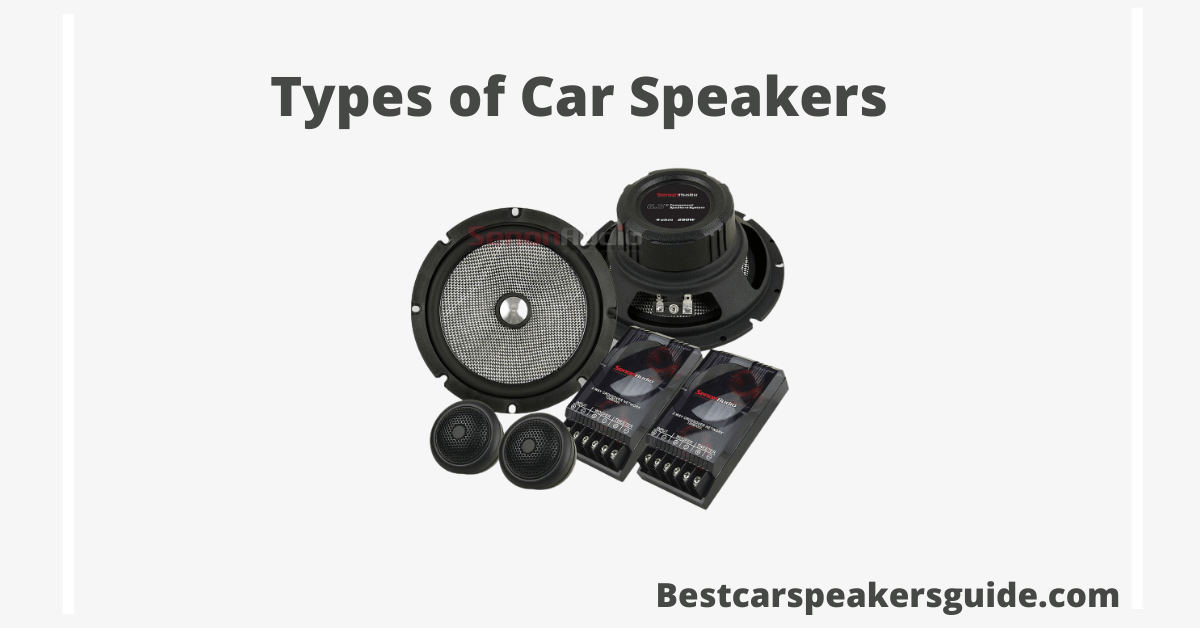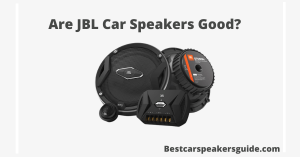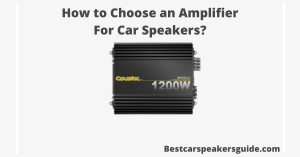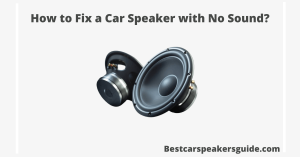You’ll want to listen to your favorite songs with the best possible sound quality, and your standard car speakers probably won’t do that for you. It would help if you decided which speakers fit on your Car and what works best to get the sound that perfectly fits your needs. There are two types of car speakers: Coaxial speakers and component speakers.
These two types of speakers have many variables to consider. Several factors, including. Sound quality, Volume, customizing, and price.
To help you choose the right speaker for your Car, let’s look at the different types of speakers available and their differences.
List of different types of Car speakers and their Size, Sound, and Quality
1. Component Speaker
Component speakers are very self-explanatory. Component speakers are designed for bass, mid or treble, providing the highest possible sound quality. Because they are separate speakers, they can be mounted in a location that best suits your application, providing a custom stereo imaging option.
This will give your music more depth and clarity and make it more immersive due to the different frequencies coming from different places. A separate crossover helps to provide a distinct sound difference across specific speakers.
The system consists of various components (speakers and drivers) installed in various locations in the Car. It’s great for customization but a lot more complicated to install.
You’ll need separate speakers to handle the bass, mids, and highs and an external crossover to control the signal. And if you don’t have the necessary skills, you’ll have to hire someone to do the installation.
You will also need a separate amplifier tailored to the speaker’s power requirements. Depending on the size of your component system, you may sometimes need multiple amplifiers.
The main advantage of component speakers is their customization. The options for setting up components are almost endless. You can install large or multiple subwoofers, as many midrange speakers as you like, and a tweeter perfectly tuned to suit your taste. You can determine and adjust its position in the Car for the best immersive music experience. Overall, Component types Car speakers are the best, especially in 2022.
2. Coaxial speaker
Having all these individual parts in one device can result in poor sound quality. Even the best coaxial speaker brands are limited by the inherent problems of the combined components. Fixing the tweeter to the speaker limits the frequency separation allowing for truly good quality sound.
Most automotive-made standard speaker systems have a coaxial setup. Simply put, coaxial is a speaker that has a full range of sound built into a single device. In most cases, they consist of woofers of various sizes with tweeters attached to poles leading to the top or center.
For coaxial speakers, drivers are placed too close to achieving true dynamic sound quality. This can sometimes be blurrily caused by different frequencies mixing in close range.
The coaxial has a simple crossover that splits the input signal into bands of high, mid, and low frequencies. It is responsible for assigning signals to different parts of the speaker. They come in several different band configurations.
3. Subwoofer
A subwoofer is a type of car speaker that produces the lowest possible sound frequencies, typically in the range of 20-200 Hz (hertz). This bass adds depth and power to the music. These speakers work best with custom box enclosures to properly contain and direct bass frequencies.
Subwoofers are usually placed behind or under the seat or in the trunk of a car. Sizes typically range from 8 inches to 15 inches.
4. Tweeter
The tweeter produces the highest sound frequencies in the range of 2000 to 20,000 Hz (usually considered the upper limit of the human ear). They provide clarity to sounds such as cymbals and voices in music. The tweeter is usually the smallest speaker in a component setup and is placed above the Car above the other drivers. Sizes range from 0.5 inches to 1.5 inches.
5. Midrange
Midrange speakers control the music’s mid-range frequencies and typically reproduce sounds in the range of 250-2000 Hz. This adds medium and clarity that a subwoofer or tweeter cannot handle.
Midrange speakers produce key details in the sound and clarity of the system. In most cases, they are round in shape and are usually placed on car doors. Typically, sizes range from 3.5 inches to 6.5 inches.
6. Woofer
Factory speaker cones are usually made of paper that degrades over time. Aftermarket speaker cones are made from durable materials that are sturdy yet lightweight. They are designed to move easily while retaining their shape for more accurate sound production.
7. Super Twitter
Finally, there’s the super tweeter for true sound enthusiasts. These are much smaller than regular tweeters and are used to compensate for high frequencies. A typical tweeter can sometimes distort or fail to process the very high frequencies of music. Super tweeters solve this problem by generating frequencies in and around the 20 kHz range.
Overall
There are many types of Car speakers you will find in the market. Your speaker setup depends entirely on your specific needs and musical taste. Coaxial Car speakers will not be enough if you’re a bass lover who likes to listen to loud dance music.
A separate custom subwoofer is required to optimize the desired low frequencies. Easy-to-install and affordable full-band coax are perfect if you’re not a music lover and want to listen to background music.
FAQs About Types of Car Speaker
What size speaker should I buy?
It’s easy to get overwhelmed by the long list of car speakers of different sizes. The good news is that you don’t have to be too obsessed with speaker size once you’ve informed the Car you’re buying and whether you’re buying front or rear speakers.
Sometimes you can choose several speaker sizes for a given location. Our rule of thumb, in this case, is the bigger, the better. So given a choice between 5-1/4 or 6×9 using brackets, you can usually use 6×9 to get more effect.
How much should I spend on car speakers?
If you’re unsure how much to spend, consider your expectations for sound and how long your vehicle will last. The entry-level to mid-range speakers are a solid choice if you’re looking for an upgrade in the factory sound of a car you plan to trade in in a few years.
If you plan to keep the Car for a while and build the system over time, investing in a premium speaker set isn’t bad either. Generally, as cost increases, the quality of design and materials improves. Better designs use power more efficiently when converting energy into sound. Better materials ensure better sound quality and long-lasting durability.
How to measure the size of a speaker?
- Follow the steps below to measure the size of your speakers.
- Examine the panel and carefully remove it.
- Remove the speaker using the Gently tool.
- Using the tape measure method, measure the mounting depth, speaker height, speaker width, and width of the screws.
- Carefully record all measurements.



